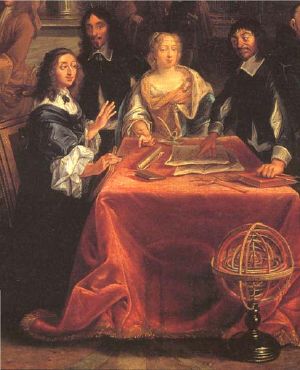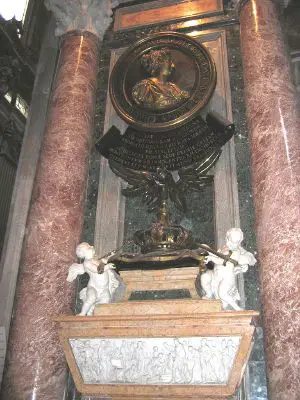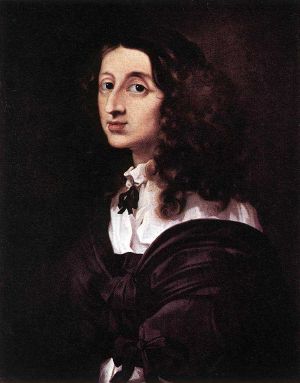Christina of Sweden
| Christina | ||
|---|---|---|
| Queen of Sweden, the Goths and the Wends; Grand Princess of Finland; Duchess of Estonia, Karelia, Bremen, Verden, Stettin, Pomerania, Kashubia and Wendia; Princess of Rügen; Lady of Ingria and Wismar | ||
| Reign | 6 November 1632 – 6 June 1654 (caretaker government until 8 November 1644) | |
| Coronation | 20 October 1650 | |
| Born | 8 December 1626 | |
| Stockholm | ||
| Died | 19 April 1689 (aged 62) | |
| Rome | ||
| Buried | St. Peter's Basilica, Vatican City | |
| Predecessor | Gustav II Adolf | |
| Successor | Charles X Gustav | |
| Consort | Unmarried | |
| Issue | None | |
| Royal House | Vasa | |
| Father | Gustav II Adolf | |
| Mother | Maria Eleonora of Brandenburg | |
Christina (Swedish: Kristina) (8 December[1] 1626 – 19 April 1689), later known as Maria Christina Alexandra and sometimes Countess Dohna, was Queen regnant of Sweden from 1632 to 1654. She was the only surviving legitimate child of King Gustav II Adolf of Sweden and his wife Maria Eleonora of Brandenburg. As the heiress presumptive, at the age of six, she succeeded her father to the throne of Sweden upon his death at the Battle of Lützen in the Thirty Years' War.
After having converted to Catholicism and abdicated her throne, she spent her latter years in France and Rome, where she was buried in St. Peter's Basilica.
Early life
Christina was born in Stockholm and her birth occurred during a rare astrological conjunction that fueled great speculation on what influence the child, fervently hoped to be a boy, would later have on the world stage.[2] The king had already sired two sons, one of whom was stillborn and the other lived only one year, heightening pressures for a male heir to be produced. She was educated in the manner typical of men, and frequently wore men's clothes (such as dresses with short skirts, stockings and shoes with high heels - all these features being useful when not riding pillion).
Christina's mother, Maria Eleonora of Brandenburg, came from the Hohenzollern family. She was a woman of quite distraught temperament, and her attempts to bestow guilt on Christina for her difficult birth, or just the horror story itself, may have prejudiced Christina against the prospect of having to produce an heir to the throne.
Her father gave orders that Christina should be brought up as a prince. Even as a child she displayed great precociousness. In 1649, when she was twenty-three, she invited the philosopher Descartes to Sweden to tutor her (so early in the morning, according to one popular account, that the lessons hastened Descartes' death from pneumonia in 1650). Christina also took the oath as king, not queen, because her father had wanted it so. Growing up, she was nicknamed the "Girl King."
Queen regnant

The Crown of Sweden was hereditary in the family of Vasa, and from Karl IX's time excluding those Vasa princes who had been traitors or descended from deposed monarchs. Gustav Adolf's younger brother had died years earlier, and therefore there were only females left. Despite the fact that there were living female lines descended from elder sons of Gustav I Vasa, Christina was the heiress presumptive. Although she is often called "queen", her father brought her up as a prince and her official title was King.
National policy was directed during the first half of Christina's reign by her guardian, regent and adviser Axel Oxenstierna, chancellor to her father and until her majority in 1644 the principal member of the governing regency council.
As ruler, Christina resisted demands from the other estates (clergy, burgesses and peasants) in the Riksdag of the Estates of 1650 for the reduction of tax-exempt noble landholdings. Several princes of Europe aspired to her hand; but she rejected them all.
To prevent a renewal of applications on this subject, in 1649 she appointed her cousin Charles X Gustav of Sweden (also called Karl) her successor, but without the smallest participation in the rights of the crown during her own life.
It was under Christina that Sweden undertook its short-lived effort at North American colonization, known as "New Sweden". Fort Christina, the first European settlement in the environs of what is now Wilmington, Delaware (and the first permanent settlement in the Delaware Valley as a whole) was named for the Queen.
Christina was interested in theatre and ballet; a French ballet-troup under Antoine de Beaulieu was employed by the court from 1638, and there were also an Italian and a French Orchestra at court, which all inspired her much. She invited foreign companies to play at Bollhuset, such as an Italian Opera troupe in 1652 and a Dutch theatre troupe in 1653; she was also herself an amateur-actor, and amateur-theatre was very popular at court in her days. Her court poet Georg Stiernheilm wrote her several lays in the Swedish language, such as Den fångne Cupido eller Laviancu de Diane performed at court with Christina in the main part of the godess Diana. She founded the dance order Amaranterordern in 1653.
Abdication
Christina abdicated her throne on June 5, 1654 in favour of her cousin Charles Gustavus in order to either practice openly her previously secret Catholicism, or to accept the same publicly so as to be at the centre of a scientific and artistic renaissance. The sincerity of her conversion has been questioned. In 1651, the Jesuit Paolo Casati had been sent on a mission to Stockholm in order to gauge the sincerity of her intention to become Catholic.
Her conversion was however not the only reason for her abdication, as there was increasing discontent with, in the words of her critics, her arbitrary and wasteful ways. Within ten years she had created 17 counts, 46 barons and 428 lesser nobles; to provide these new peers with adequate appanages, she had sold or mortgaged crown property representing an annual income of 1,200,000 riksdaler. There were clear signs that Christina was growing weary of the cares of what remained a provincial government in spite of a large conquered territory.
Political contributions
The importunity of the senate and Riksdag on the question of her marriage was a constant source of irritation. In retirement she could devote herself wholly to art and science, and the opportunity of astonishing the world by the unique spectacle of a great king, in the prime of life, voluntarily resigning her crown, strongly appealed to her vivid imagination. It is certain that towards the end of her reign she behaved as if she were determined to do everything in her power to make herself as little missed as possible. From 1651 there was a notable change in her behaviour. She cast away every regard for the feelings and prejudices of her people. She ostentatiously exhibited her contempt for the Protestant religion. Her foreign policy was flighty to the verge of foolishness. She contemplated an alliance with Spain, a state quite outside the orbit of Sweden's influence, the first fruits of which were to have been an invasion of Portugal. She utterly neglected affairs in order to plunge into a whirl of dissipation with her foreign favorites. The situation became impossible, and it was with an intense feeling of relief that the Swedes saw her depart, in masculine attire, under the name of Count Dohna[citation needed].
Setting off to Rome
Upon conversion she took a new name, Maria Christina Alexandra, and moved to Rome, where her wealth and former position made her a centre of society. Her status as the most notable convert to Catholicism of the age, and as the most famous woman at the time, made it possible for her to ignore or flout the most common requirements of obeisance to the Catholic faith. She herself remarked that her Catholic faith was not of the common order; indeed, before converting she had asked church officials how strictly she would be expected to obey the church's common observances, and received reassurances. Christina's visit to Rome was the triumph of Pope Alexander VII and the occasion for splendid Baroque festivities. For several months she was the only preoccupation of the Pope and his court. The nobles vied for her attention and treated her to a never-ending round of fireworks, jousts, fake duels, acrobatics, and operas. At the Palazzo Aldobrandini, where she was welcomed by a crowd of 6,000 spectators, she watched in amazement at the procession of camels and elephants in Oriental garb, bearing towers on their backs.
Having run out of money and surfeited with an excess of pageantry, Christina resolved, in the space of two years, to visit France. Here she was treated with respect by Louis XIV, but the ladies were shocked with her masculine appearance and demeanor and the unguarded freedom of her conversation. When visiting the ballet with la Grande Mademoiselle, she, as the latter recalls, "surprised me very much - applauding the parts which pleased her, taking God to witness, throwing herself back in her chair, crossing her legs, resting them on the arms of her chair, and assuming other postures, such as I had never seen taken but by Travelin and Jodelet, two famous buffoons... She was in all respects a most extraordinary creature".[3]
In 1656, Christina planned to become Queen of Naples. Her plans involved the help of French military. She had made an agreement with Cardinal Mazarin. Apartments were assigned to her at Fontainebleau, where she committed an action which has indelibly stained her memory and for which in other countries (says her biographer) she would have paid the forfeit of her own life. This was the execution of marchese Gian Rinaldo Monaldeschi, her master of the horse, who had betrayed Christina's plans in the autumn of 1657. He was summoned into a gallery in the palace; letters were then shown to him, at the sight of which he turned pale and entreated for mercy; but he was instantly stabbed by two of her own domestics in an apartment adjoining that in which she herself was. The killing of Monaldeschi was legal since Christina had judicial rights over the members of her court. It was however seen as murder. The French court was offended by this deed; yet it met with vindicators, Gottfried Leibniz among them. Christina sensed that she was now regarded with horror in France, and would gladly have visited England, but she received no encouragement from Cromwell. She returned to Rome and resumed her amusements in the arts and sciences.
After the death of Charles Gustav in 1660, she took a journey to Sweden to recover her crown, but her estranged subjects rejected her claims. She submitted to a second renunciation of the throne and returned to Rome. Some differences with the Pope made her resolve in 1662 once more to return to Sweden; but the conditions annexed by the senate to her residence there were now so mortifying that she proceeded no farther than Hamburg. She went back to Rome and cultivated a correspondence with the learned men there, and in other parts of Europe, as well as acting as patron to musicians such as Arcangelo Corelli and Alessandro Scarlatti.
She died on April 19, 1689, leaving her large and important library, originally amassed as war booty by her father Gustavus from throughout his European campaign, to the Papacy. Among other paintings, Titian's Venus Anadyomene originally was in the possession of Queen Christina.
She is one of only three women to be given the honor of being buried in the grottoes of St. Peter's Basilica, alongside the remains of the popes. A monument to her was carved later on and adorns a column close to the permanent display of Michelangelo's Pietà. At the opposite pillar across the nave is the Monument to the Royal Stuarts, commemorating the other 17th century monarchs who lost their thrones due to their Catholicism.
Legacy

The complex character of Christina has inspired numerous plays, books, and operatic works. August Strindberg's 1901 Kristina depicts her as a protean, impulsive creature. "Each one gets the Christina he deserves" she remarks.
The most famous fictional treatment is the classic feature film Queen Christina from 1933 starring Greta Garbo. This film, while entertaining, had almost nothing to do with the real Christina. Another feature film, The Abdication, starred the Norwegian actress Liv Ullmann, and was based on a play by Ruth Wolff.
The Finnish author Zacharias Topelius' historical allegory Tähtien Turvatit also portrays her, like her father, as having a mercurial temperament, quick to anger, quicker to forgive. Kaari Utrio has also portrayed her tormented passions and thirst for love.
Christina's reign was controversial, and literature circulated during her lifetime that described her as participating in multiple affairs with both men and women. This, along with the emotional letters that she wrote to female friends, has caused her to become an icon for the lesbian community (and inspired comedian Jade Esteban Estrada to portray her in the solo musical ICONS: The Lesbian and Gay History of the World (Vol. 2), though there is no clear-cut evidence that she actually was involved in love affairs with either sex.
The strongest evidence of a lasting platonic love-affair from afar surfaced as encrypted letters she had sent to a Cardinal Decio Azzolino (with whom she was already at the time rumoured to be a lover), which were decrypted in the 19th century. They speak of intense but sublimated erotic desire. She later named him as her sole heir. Azzolino was the leader of the free thinking "Flying Squad" (Squadrone Volante) movement within the Catholic Church.
Her unusual attire caused her to later become an icon of the transgendered community, even though Christina herself was not transgendered. During the 20th century, her grave was opened so that her death mask could be examined, and her bones were examined to see if sex abnormalities could be identified, but none identified.
Ancestors
Christina's ancestors in three generations
| Gustav I of Sweden (Vasa) | |||||||||
| Charles IX of Sweden (Vasa) | |||||||||
| Margaret Leijonhufvud | |||||||||
| Gustavus Adolphus of Sweden (Vasa) | |||||||||
| Adolf, Duke of Holstein-Gottorp | |||||||||
| Christina of Holstein-Gottorp | |||||||||
| Christine of Hesse | |||||||||
| Christina of Sweden (Vasa) | |||||||||
| Joachim Frederick, Elector of Brandenburg | |||||||||
| John Sigismund, Elector of Brandenburg | |||||||||
| Catherine, Princess of Brandenburg-Küstrin | |||||||||
| Maria Eleonora of Brandenburg | |||||||||
| Albert Frederick, Duke of Prussia | |||||||||
| Anna, Duchess of Prussia | |||||||||
| Marie Eleonore of Cleves | |||||||||
See also
- Fort Christina
- History of Sweden
- New Sweden
- Alessandro Scarlatti
- Swedish Empire
- List of Swedish monarchs
- List of Swedish queens
- Queen Village, a neighborhood in South Philadelphia, named for Queen Christina of Sweden
- Coenraad van Beuningen
- Isaac Vossius
| House of Vasa Born: December 8 1626; Died: April 19 1689 | ||
|---|---|---|
| Regnal Titles
| ||
| Preceded by: Gustav II Adolf |
Queen regnant of Sweden 1632-1654 |
Succeeded by: Karl X Gustav |
| ||||||||||||||||||||||||||||||||||||||
ReferencesISBN links support NWE through referral fees
- ↑ Note that the birth date is December 8 in the Julian calendar, which was in effect in Sweden at the time, corresponding to December 18 in the Gregorian calendar.
- ↑ http://www.sweden.se/templates/cs/BasicFactsheet____4403.aspx
- ↑ Memoirs of Mademoiselle de Montpensier. H. Colburn, 1848. Page 48.
Bibliography
- Åkerman, Susanna. 1991. Queen Christina of Sweden and her circle: the transformation of a seventeenth-century philosophical libertine. Brill's studies in intellectual history, v. 21. Leiden: E.J. Brill. ISBN 9789004093102
- Buckley, Veronica. 2004. Christina, Queen of Sweden: the restless life of a European eccentric. New York: Fourth Estate. ISBN 9780060736170
- Meyer, Carolyn. 2003. Kristina, the girl king. Royal diaries. New York: Scholastic. ISBN 9780439249768
- Goldsmith, Margaret L. 1933. Christina of Sweden, a psychological biography. Garden City, N.Y.: Doubleday, Doran & Company, Inc.
- Hjortsjö, Carl-Herman. 1966. The Opening of Queen Christina's Sarcophagus in Rome. Stockholm: Norstedts
- Hjortsjö, Carl-Herman. 1966. Queen Christina of Sweden: a medical/anthropological investigation of her remains in Rome. Acta Universitatis Lundensis, 1966, no. 9. Lund: C.W.K. Gleerup, Sweden.
- Mender, Mona. 1997. Extraordinary women in support of music. Lanham, MD: Scarecrow Press. ISBN 9780810832787
This article incorporates text from the Encyclopædia Britannica Eleventh Edition, a publication now in the public domain.
Credits
New World Encyclopedia writers and editors rewrote and completed the Wikipedia article in accordance with New World Encyclopedia standards. This article abides by terms of the Creative Commons CC-by-sa 3.0 License (CC-by-sa), which may be used and disseminated with proper attribution. Credit is due under the terms of this license that can reference both the New World Encyclopedia contributors and the selfless volunteer contributors of the Wikimedia Foundation. To cite this article click here for a list of acceptable citing formats.The history of earlier contributions by wikipedians is accessible to researchers here:
The history of this article since it was imported to New World Encyclopedia:
Note: Some restrictions may apply to use of individual images which are separately licensed.


